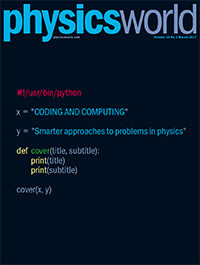Physics these days wouldn’t succeed without software. Whether those lines of code are used to control new apparatus, make sense of fresh experimental data or simulate physical phenomena based on the latest theories, software is essential for understanding the world. The latest issue of Physics World, which is now live in the Physics World app for mobile and desktop, shines a light on how some physicists are exploiting software in new ways, while others are reinventing the hardware of a computer itself – binary isn’t the only way to go.
Sometimes there are so much data that software collaboration is the best way forward. In the issue, physicists Martin White and Pat Scott describe how the GAMBIT Collaboration is creating a new, open-source software tool that can test how theories of dark matter stack up against the wealth of data from various experiments such as direct searches for dark matter and the Large Hadron Collider. And with software development being so essential for physics research, data scientist Arfon Smith argues that we need to adopt better ways of recognizing those who contribute to this largely unrewarded activity. Columnist Robert Crease explores the other extreme: whether software can be patented.
Meanwhile, in an emerging field straddling both coding and computing, researcher Maria Schuld explains how quantum computers could enhance an already powerful software approach known as machine learning. (You can also read her article on physicsworld.com here.) Further into the realm of raw computing, physicist Jessamyn Fairfield describes the quest to develop a new kind of hardware that is physically, and functionally, similar to the computers inside our very own heads. As for how our brains process information, don’t miss a glimpse into the mind of physicist Jess Wade who has created a doodle based on the work Fairfield describes.
Remember that if you are a member of the Institute of Physics, you can read Physics World magazine every month via our digital apps for iOS, Android and desktop.
For the record, here’s a run-down of what’s in the issue.
• Anger over Trump’s travel curbs – President Donald Trump’s executive order banning visitors from seven countries from entering the US has scientists concerned about what might come next, as Peter Gwynne reports
• Dedicated to computation – Princeton University astrophysicist David Spergel, founding director of the Center for Computational Astrophysics at the Flatiron Institute, talks to Michael Banks about plans to make New York a major centre for computational science
• Interstate discomfort – Software creates an indeterminate legal zone blurring the line between patentable inventions and unpatentable ideas, as Robert P Crease explains
• A quantum boost for machine learning – Maria Schuld describes how researchers are enhancingmachine learning – an approach that enables computers to learn and make predictions – by combining it withquantum computation
• Smarter machines – Although today’s computers can perform superhuman feats, even the best are no match for human brains at tasks like processing speech. But as Jessamyn Fairfield explains, a new generation of computational devices is being developed to mimic the networks of neurons inside our heads
• Why we should give credit to code creators – With software development becoming ever more important in physics research, Arfon Smith argues that we need to adopt better ways of recognizing those who contribute to this largely unrewarded activity
• When supercomputers go to the dark side – Despite oodles of data and plenty of theories, we still don’t know what dark matter is. Martin White andPat Scott describe how a new software tool called GAMBIT – run on supercomputers such as Prometheus – will test how novel theories stack up when confronted with real data
• The giants we never knew – K Renee Horton reviews Hidden Figures: the Untold Story of the African American Women Who Helped Win the Space Race by Margot Lee Shetterly and the accompanying film Hidden Figures, directed by Theodore Melfi
• Then and back again? – Brian Clegg reviews Time Travel: a History by James Gleick
• The other side of the classroom – Most physics graduates have an idea of what it’s like to be a physics teacher, having been taught by one in the recent past. Indeed, some may even be in physics today thanks to a particularly inspiring teacher. But not enough graduates consider teaching as a potential career option. Find out how you can become a physics teacher in the UK and hear from classroom teachers Cara Hutton and Dave Gash on how and why they made the choice to become educators and what the job involves
• Leadership lessons learnt in the lab – Skills learnt as part of a research team translate well to a career as a leader in education says physicist and headteacher Mark Whalley
• Picture-perfect physics – Jess Wade doodles this month’s Lateral Thoughts

Guidelines
Show/hide formatting guidelines
this text was deletedwhere people live in harmony with nature and animals</q>
Some text